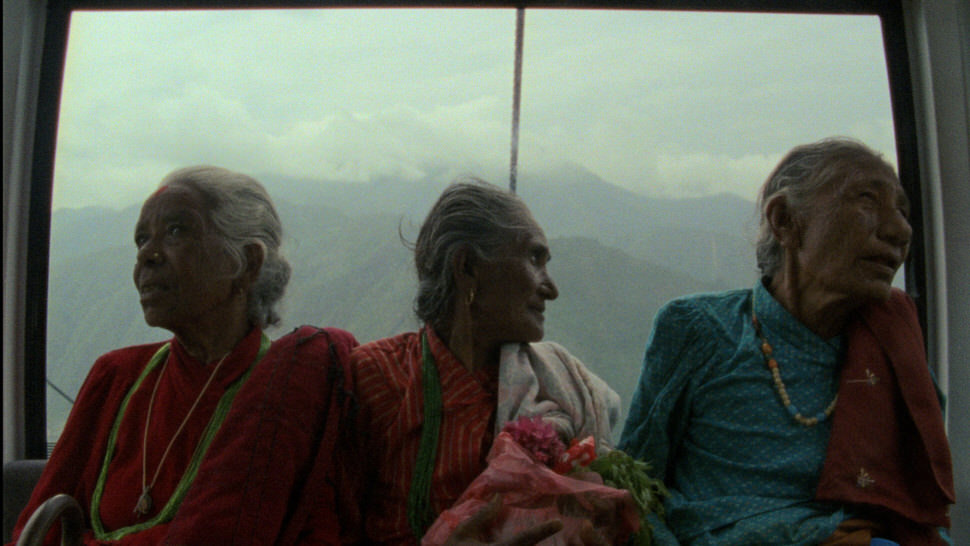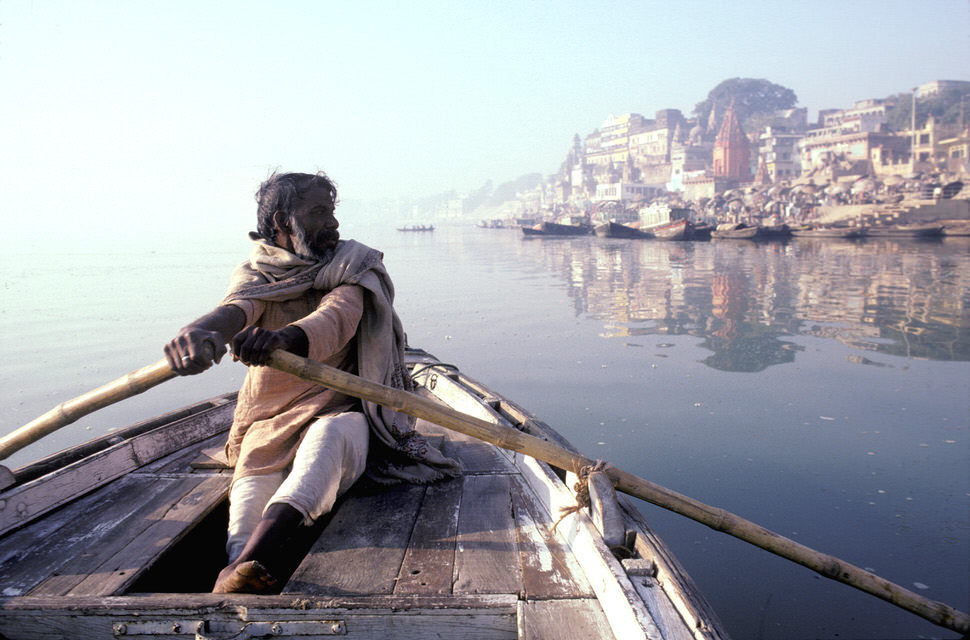Manakamana, the new documentary by anthropologist Stephanie Spray and filmmaker Pacho Velez, is a motion picture that transports the viewer to a mountaintop Hindu temple, as well as back in time to the medium’s dawn.
Shot in the skies above Nepal,**the film uses a fixed 16mm camera to document a varied succession of pilgrims, some with gifts for the goddess Bhagwati, as they are conveyed via cable car over a jungle valley and up to or back from the seventeenth-century shrine, known as the Manakamana Temple. There are five ascents to and six descents from the mountain—an eleven-act vaudeville show in which the individual trips are separated by a clattering landing and an invisible cut made during the darkness of the turn-around.
Although Manakamana *involved filming thirty-five round trips—taken mainly by inhabitants of the village where Spray did her fieldwork—and took eighteen months to assemble, it is a work of great simplicity, suggesting the ethnographic origins of documentary film. (The word “documentary” was coined by John Grierson to describe Robert Flaherty’s 1926 *Moana, a Samoan idyll much admired by the Surrealists for its inadvertently fantastic treatment of daily life.) Indeed, ethnographic cinema is nearly as old as cinema itself. Scarcely had the Lumière brothers demonstrated their cinematograph in 1895 than the anthropologist Félix-Louis Regnault repurposed the Lumières’s single-shot actualités to document a Wolof woman making a ceramic pot at the Paris Exposition Ethnographique de l’Afrique Occidentale.
Manakamana also reminds us that the first motion pictures were largely about motion, including the sensation of apparent motion. An early rival of the turn-of-the-twentieth-century nickelodeons were the Hale’s Tours, theaters that simulated railroad journeys, with viewers seated in gently rocking carriages while a moving landscape was projected outside their vehicle’s windows. Spray and Velez’s film, which is set entirely inside the cable car on its ride to the mountain temple, evokes this sort of trip.
The first travelers to make the ascent are an old man and a little boy, both looking around, neither speaking. They are followed by a nervous single woman; a middle-aged couple with downcast eyes and, as becomes apparent midway through their trip, a sacrificial rooster; a trio of elderly ladies, one of whom starts praying to the goddess; a thoroughly secular AC/DC cover band, with long hair and rocker T-shirts, who express an interest in making a music video in the cable-car; and, most affectingly, four frightened goats huddled together.
The reverse trips are made by another single middle-aged woman; a pair of American girls chatting about the travel journals they are keeping; an elderly woman and her daughter, who unwrap some messy ice-cream pops (“We’re like children, still learning to eat,” the daughter laughs); and, in a sublimely orchestrated touch, two musicians, each with a fretted sarangi, who tune their instruments and begin to play. The last gondola holds the middle-aged couple returning, without their rooster.
Manakamana is the latest feature to emerge from the Sensory Ethnography Lab, which was established at Harvard in 2006 by the filmmaker and theorist Lucien Castaing-Taylor. The university has a long and distinguished commitment to documentary cinema, in part because its Film Study Center was founded by the ethnographic filmmaker Robert Gardner. Scion of a Brahman family and thus his own patron, Gardner is at once the establishment Gauguin and the avant-garde Indiana Jones—a documentarian whose aesthetic interests brought him increasingly close to the work of experimental film artists.
The Sensory Ethnography Lab, or SEL, is very much in the Gardner tradition. (The program is jointly run by Harvard’s Department of Anthropology and Department of Visual and Environmental Studies, which houses Cinema studies, as well as filmmaking and studio art—and where I have been a visiting professor for the past year.) First-person “documentaries” like Peter Kubelka’s densely edited, commissioned “home movie” of Europeans on safari, Unsere Afrikereise, and Stan Brakhage’s unflinching impressions of a Pittsburgh morgue, The Act of Seeing with One’s Own Eyes—visionary works conceived and made by individual artists in 16mm—are near sacred texts. Several SEL films are included in the current Whitney Biennial; a number of others, along with Gardner’s voluptuous chef d’oeuvre Forest of Bliss, a wordless, near hallucinatory portrait of funeral practices in Varanasi, are also featured in the innovative documentary series “The Art of the Real” (showing at New York’s Lincoln Center through April 26).
In their general approach, SEL movies have explored two tendencies in ethnographic cinema. Some, following Forest of Bliss, are expressionist, verging on gothic; among these is Yumen which, made in northwestern China by J.P. Sniadecki and two Chinese colleagues, Huang Xiang and Xu Ruotao, depicts a derelict boomtown as the site of a mysterious catastrophe. The most celebrated is Castaing-Taylor and Véréna Paravel’s Leviathan, a clamorous, convulsive account of commercial fishing in the North Atlantic that, due to its near ballistic use of waterproof, wearable GoPro cameras, is both the most formally radical documentary and most widely seen avant-garde film of the past few years. (An installation fashioned from Leviathan is included in the Whitney show.)
Advertisement
The second SEL tendency is related to the rigorous, observational style developed by the filmmakers David and Judith MacDougall in their studies of the Turkana herdsmen of northern Kenya, a cinema of long takes and discrete vignettes. This structuralist methodology is exemplified by Sniadecki and Lily Cohn’s People’s Park—a continuous seventy-five-minute dolly shot traversing a well-used municipal park in the Chinese city of Chengdu on a summer afternoon—and by Manakamana.
Manakamana’s own spectacle of humans and animals in space—some perhaps contemplating eternity, others simply marveling at the landscape around the temple—lends itself to allegory. Are we watching something like the transmigration of souls? Manakamana has a certain resemblance to Standish Lawder’s 1970 Necrology, a fixed-camera structural film that used a telephoto lens to document stoical commuters on a crowded down-escalator at Grand Central Station and ran the film in reverse to suggest ascension into the afterlife. Unlike Necrology, Manakamana is airy, detailed, and filled with unexpected bits of business.
Manakamana’s eleven-minute takes exist somewhere on the continuum between the head-on subject-camera confrontation of Andy Warhol’s mid-1960s screen tests and the kitschy posed souvenir portraits people used to have taken at amusement parks; they are long enough, however, to document a specific situation. The movie not only captures the play of light and shadow but what might be called the play of consciousness. The subjects occasionally acknowledge the filmmakers, both of whom were evidently squeezed in along with their Bolex on the opposite side of the five-by-five foot gondola. Mainly, however, they experience their trip, commenting on the landscape and/or the cable car, which, built in 1998, is something of a novelty—eliminating the trek up the mountain that had been required for centuries, this motorized ascent embodies modern technology.
As the pilgrims consider the sights and sensations of the journey and the flux of their own, unknowable internal monologues, the viewer is free to observe their observations. Presenting Manakamana at last fall’s New York Film Festival, Spray called each episode “a whole ethnographic encounter in real time.” It might be more precise to say that this hypnotic and serene motion picture allows the viewer to experience what that thing “real time” really is.
Stephanie Spray and Pacho Velez’s Manakamana will open at New York’s IFC theater on April 18, with screenings in other American cities to follow.




